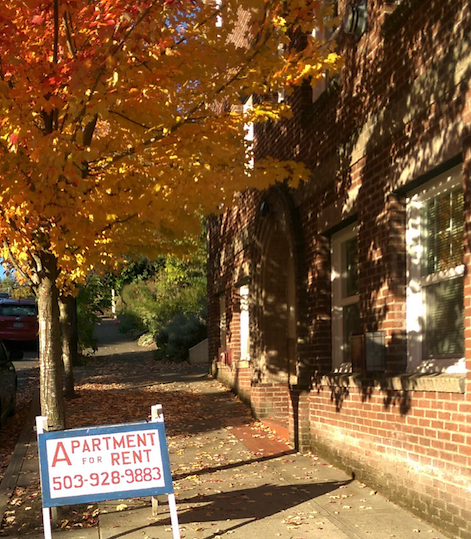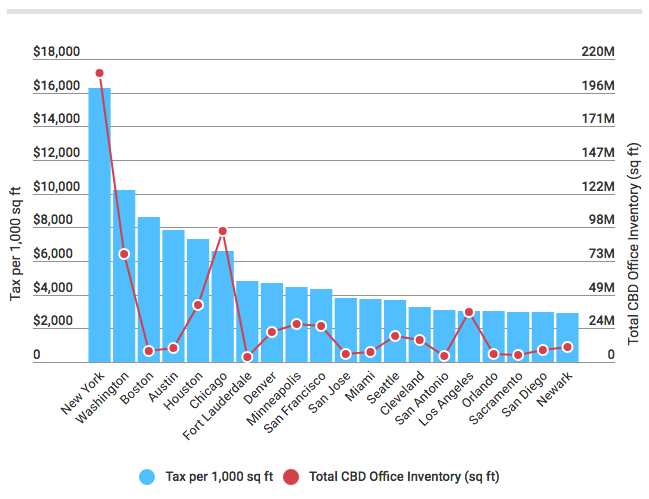What City Observatory did this week
1. Signs of the times. For most of the past few years, Portland–like other flourishing metro economies–has seen significant increases in apartment rents, as demand for urban living has outstripped local supply. There’s evidence that situation is changing–in the form of a bumper crop of “For Rent” signs in front of apartments all around the city. The construction of new apartments (there are now 19,000 in the development pipeline in the city) is starting to ease the supply crunch. Data from Zillow shows that rent inflation has fallen from the double-digits in 2016 to less than zero today. The “For Rent” signs foretell a likely decrease in rents in the months ahead, and also dispel two of the most common myths about the housing market.
2. The hamster wheel school of transportation policy. One of the most widely used metrics of transportation system performance is average travel speeds. But does going faster get us anywhere, and perhaps more importantly, make us happier? The evidence suggests not. We compared data on average travel speeds in metropolitan areas with survey data on how happy local citizens were with their local transportation system. Actually, people are happier in places where average speeds are lower. It turns out that faster moving places have more sprawl and longer average trips, and together, the negative effects of greater distance more the offset the illusory, hamster-wheel, advantage of moving faster.
Must read
We’re especially lucky this week; two of the sharpest writers on urban economics have long-form pieces on the plight of declining cities and regions.
1. Alex Baca on Reimagining the RustBelt. There’s been more than a little diagnosis of the ills of the Rust Belt, how they’ve infected the national body politic, and what might be done. After sitting through a long talking head session featuring economic development luminaries ranging from JD Vance to Joel Kotkin commenting on the release of a report called ““The New American Heartland: Renewing the Middle Class by Revitalizing Middle America,” Baca offers some trenchant and perceptive analysis. What’s being prescribed for struggling rustbelt cities is more of the same corporate urbanism–reducing regulation and cutting taxes, with hopes of attracting external investment–that’s failed them for decades. It may be dressed up in new rhetoric that suits the tenor of Trumpian times, but underneath its still the same flawed message. An important and well-argued read.
2. Ryan Avent on declining regions in The Economist. In contrast to the warmed over platitudes in the “Heartland” report skewered by Alex Baca, Ryan Avent offers a more nuanced and global perspective on the plight and prospects of declining regions. Throughout the developed world, the kind of middle-wage, routine manufacturing that clustered in relatively low cost smaller metros and rural areas has been in decline, dragging down surrounding economies. Ryan Avent takes a close look at the impact of globalization, the rise of urban, knowledge-based industries, and the slowing of migration within richer countries, all of which have contributed to declining regions. The causes seem well defined; the solutions are less clear.
3. Smart phones are killing Americans, but we don’t know how many. Bloomberg BusinessWeek digs into the arcane data on traffic crashes to see what we know about the role that smartphones play in distracted driving. Official records report that only about 1 percent of fatalities involve smartphone distraction, But there’s a tremendous blind spot in data collection. Few crash reporting systems have a convenient way to record whether a smartphone was being used at the time of crash. One state (Tennessee) that has a reporting system that specifically probes for evidence of distraction, including phone use; with just 2 percent of the nation’s population, it accounts for nearly 20 percent of distraction fatalities. This is strong evidence that techno-distracted driving is greatly under-reported. In light of all the triumphalism about technology and smart transportation, the lack of data about whether this technology contributes to distraction and crashes is a major paradox.
4. Writing in the New York Times, Alison Arieff chronicles the many ways we’ve made public spaces inhospitable to the public. In many places, like parks, squares, and streets, city officials have removed benches, or purposely engineered them to be uncomfortable. Too often, were sending a clear message that we don’t want people to linger in the public realm. Eliminating seating is emblematic of a whole class of policies and design choices, from single-family zoning to cul-de-sac street patterns, that limit or debase the prospects of being in public with others. Writ large, this trend undercuts the fundamental nature of community. Restoring the civic commons will hinge on a wide-ranging re-thinking of many of the aspects of place that we’ve taken for granted.
New Knowledge
Property tax levels on downtown office buildings. Based in part on data from real estate analytics firm Yardi Matrix, Commercial Cafe has generated estimates of the average level of property taxes paid per square foot for office space in 40 of the nation’s largest central business districts. In most major markets, the cost of taxes runs to about $2,000 to $3,000 per thousand square feet, but there’s considerable variation. Unsurprisingly, the nation’s largest cities have the highest tax rates; New York’s tax burden works out to more than $16,000 per 1,000 square feet and about $10,000 per thousand square feet in Washington, DC. Four other markets (Boston, Austin, Houston and Chicago) have property taxes of between $5,000 and $10,000 per thousand square feet. The Commercial Cafe data are great for benchmarking property taxes, but keep in mind that every city has its own distinct panoply of fees, taxes and tax breaks, so these numbers may not tell the whole picture on how much it costs for public sector charges associated with office space in each city.
In the News
Moody’s Economics in handicapping Austin as the leading contender to land Amazon’s HQ2 project, according to Business Insider which quotes Joe Cortright’s observation that it’s likely that the company has already narrowed its list of likely candidates to just a handful, and is chiefly using the very public beauty contest to improve its negotiating position.




